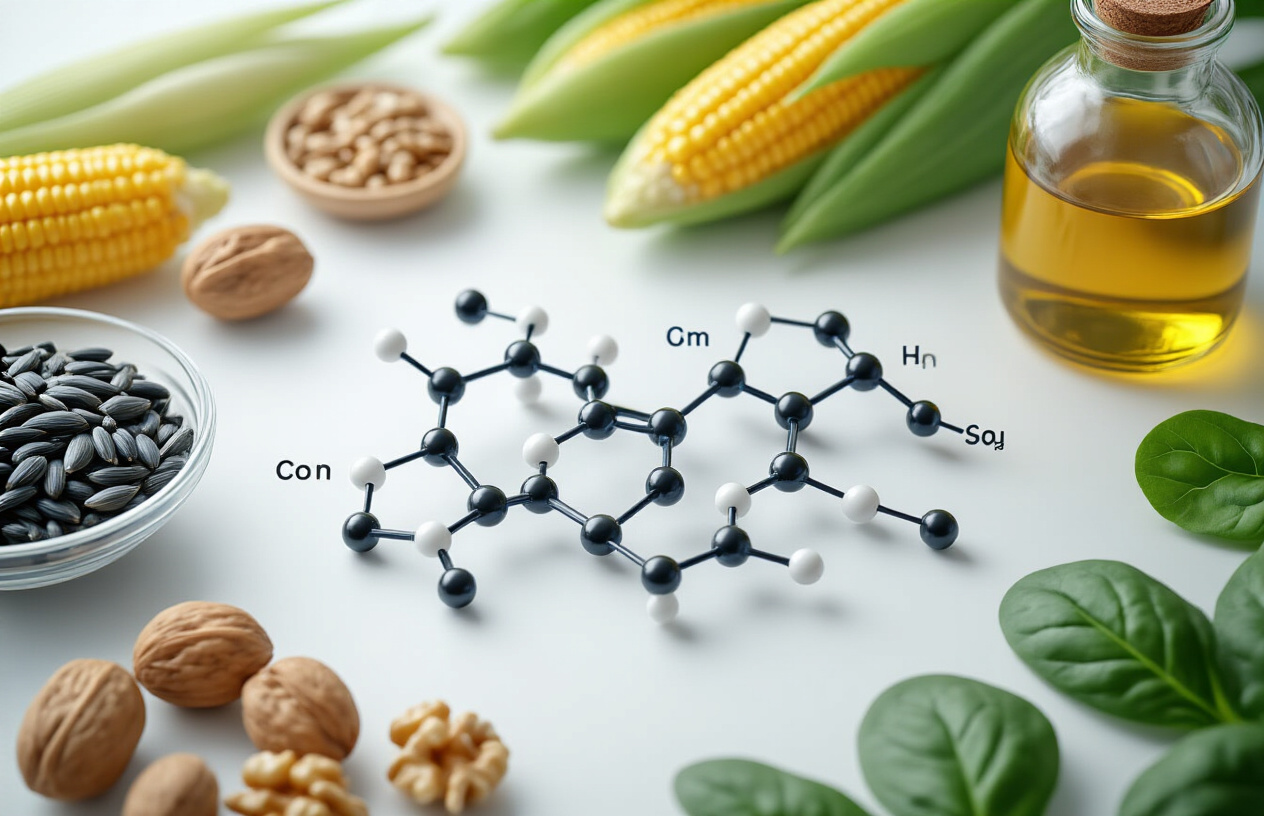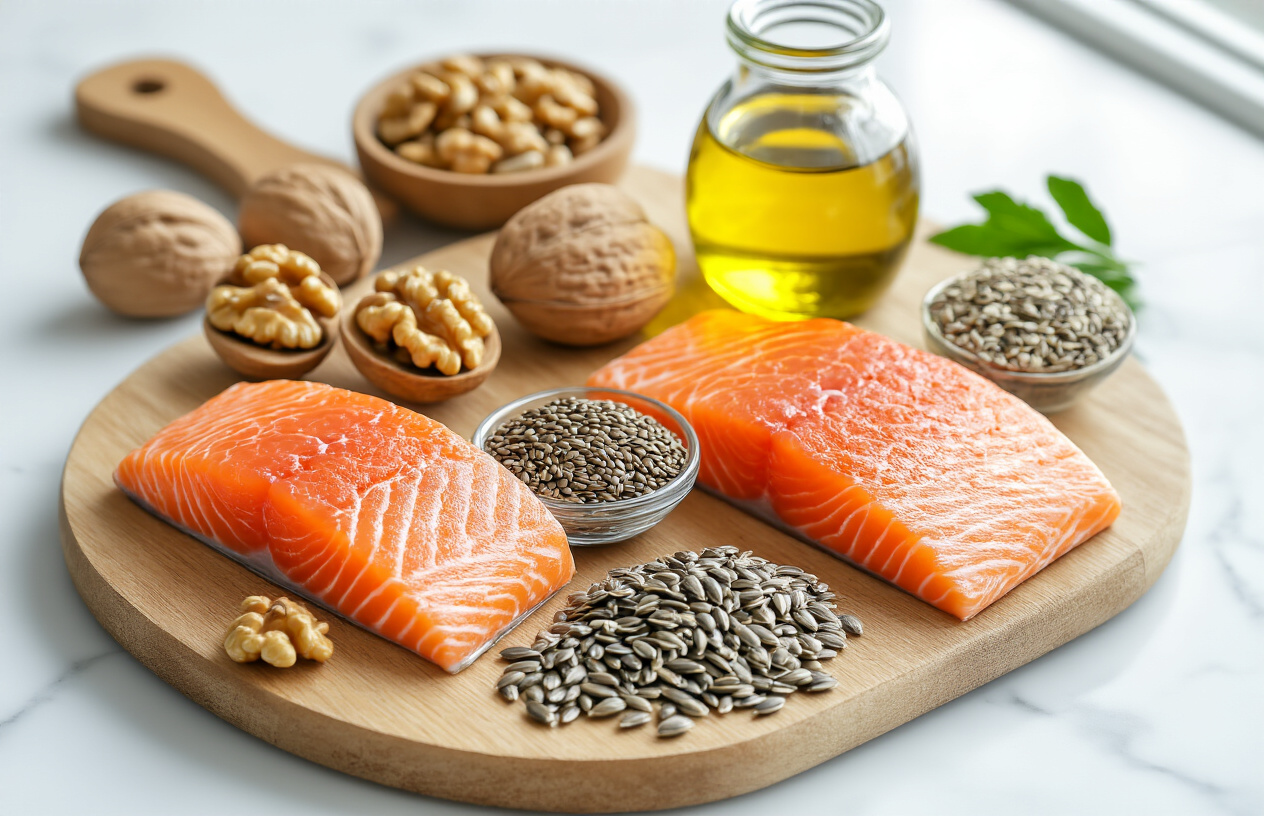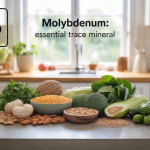Omega-6 fatty acids are essential fats your body needs but can’t make on its own. This guide is for anyone curious about these important nutrients and how they affect your health.
You’ve probably heard conflicting information about omega-6s – some sources praise them while others warn against eating too much. The truth is more balanced than you might expect.
We’ll explore what makes omega-6 fatty acids unique and where you’ll find them in everyday foods. You’ll also learn about their key health benefits and why getting the right balance with omega-3s matters for your overall wellness.
Understanding Omega-6 Fatty Acids and Their Basic Structure

Chemical composition and molecular structure of omega-6 fats
Omega-6 fatty acids belong to a family of polyunsaturated fats characterized by their unique molecular structure. These molecules contain a long carbon chain with multiple double bonds, with the first double bond located at the sixth carbon atom from the omega (methyl) end of the chain. This specific positioning gives omega-6 fats their name and distinguishes them from other fatty acid types.
The carbon chain typically ranges from 18 to 22 carbons long, creating a flexible, kinked structure due to the double bonds. This molecular architecture allows omega-6 fats to remain liquid at room temperature and influences how they function within cell membranes. The double bonds create bends in the fatty acid chain, preventing tight packing and maintaining membrane fluidity.
How omega-6 differs from other essential fatty acids
Omega-6 fatty acids stand apart from their omega-3 counterparts primarily through their structural differences and biological functions. While omega-3 fats have their first double bond at the third carbon position, omega-6 fats have theirs at the sixth position. This seemingly small difference creates vastly different effects in your body.
The structural variation influences how these fats interact with enzymes and cellular processes. Omega-6 fats generally promote inflammatory responses when needed, while omega-3 fats typically have anti-inflammatory properties. Both types compete for the same enzymes during metabolism, which explains why the ratio between them matters so much for optimal health.
Unlike saturated fats, which have no double bonds, or monounsaturated fats with just one double bond, omega-6 fats contain multiple double bonds that make them highly reactive and prone to oxidation when exposed to heat, light, or air.
Why your body cannot produce these fats naturally
Your body lacks the specific enzymes needed to create double bonds at the omega-6 position in fatty acid chains. Humans can synthesize many fatty acids through various metabolic pathways, but we cannot introduce double bonds beyond the ninth carbon from the carboxyl end of the fatty acid chain.
This enzymatic limitation makes omega-6 fats “essential,” meaning you must obtain them through your diet. Your liver can perform many impressive biochemical transformations, including converting one fatty acid into another, but it cannot create omega-6 fats from scratch or from other fatty acid types.
Once consumed, your body can modify omega-6 fats by elongating the chain or adding more double bonds, but the initial omega-6 structure must come from food sources. This dependency on dietary intake makes choosing the right food sources particularly important for maintaining optimal health.
Common types of omega-6 fatty acids you encounter daily
Linoleic acid (LA) represents the most abundant omega-6 fatty acid in the typical diet. Found in vegetable oils like soybean, corn, and sunflower oil, LA serves as the parent compound for other omega-6 derivatives. Your body uses LA to produce arachidonic acid (AA), a more complex omega-6 fat that plays crucial roles in immune function and inflammation.
Gamma-linolenic acid (GLA) appears in smaller quantities in foods like evening primrose oil and borage oil. Unlike other omega-6 fats, GLA can have anti-inflammatory properties under certain conditions, making it unique within the omega-6 family.
Arachidonic acid occurs naturally in animal products, particularly in meat, poultry, and eggs. This omega-6 fat directly influences inflammatory pathways and serves as a precursor to various signaling molecules called eicosanoids, which regulate immune responses, blood clotting, and other vital functions.
Dihomo-gamma-linolenic acid (DGLA) acts as an intermediate compound in omega-6 metabolism, sitting between GLA and arachidonic acid in the metabolic pathway. While less discussed, DGLA contributes to the complex balance of inflammatory and anti-inflammatory processes in your body.
Top Food Sources Rich in Omega-6 Fatty Acids

Vegetable oils with highest omega-6 content
Safflower oil tops the charts with an impressive 75% omega-6 fatty acid content, making it one of the richest dietary sources available. This light, neutral-flavored oil is commonly used in commercial food production and cooking applications. Sunflower oil follows closely behind, containing approximately 65% omega-6 fatty acids, particularly linoleic acid.
Corn oil packs around 60% omega-6 content and remains a staple in many American kitchens due to its affordability and high smoke point. Soybean oil, found in countless processed foods, contains about 50% omega-6 fatty acids and represents the most widely consumed oil globally. Cottonseed oil delivers roughly 50% omega-6 content, though it’s less common in home cooking.
Sesame oil provides about 45% omega-6 fatty acids while adding distinctive nutty flavors to dishes. Grapeseed oil contains approximately 70% omega-6 content and has gained popularity among health-conscious consumers despite its high polyunsaturated fat profile.
| Oil Type | Omega-6 Content (%) | Common Uses |
|---|---|---|
| Safflower | 75% | Salad dressings, baking |
| Sunflower | 65% | Frying, cooking |
| Grapeseed | 70% | High-heat cooking |
| Corn | 60% | General cooking |
| Soybean | 50% | Processed foods |
Nuts and seeds that boost your omega-6 intake
Walnuts stand out among tree nuts, containing about 38 grams of omega-6 per 100-gram serving, primarily in the form of linoleic acid. Pine nuts deliver approximately 34 grams per 100 grams, making them exceptionally rich sources. Brazil nuts provide around 24 grams of omega-6 fatty acids per 100-gram portion.
Sunflower seeds pack an impressive 23 grams of omega-6 per 100 grams, making them convenient snack options for boosting intake. Pumpkin seeds contain roughly 19 grams per 100 grams while offering additional minerals like zinc and magnesium. Sesame seeds provide about 21 grams of omega-6 fatty acids per 100-gram serving.
Pecans deliver approximately 22 grams of omega-6 per 100 grams, while almonds contain a more moderate 12 grams per 100-gram portion. Cashews provide around 8 grams per 100 grams, making them lower in omega-6 compared to other nuts.
Hemp seeds offer about 28 grams of omega-6 per 100 grams along with complete protein profiles. Chia seeds contain roughly 6 grams per 100 grams but provide better omega-3 to omega-6 ratios compared to most other seeds.
Processed foods loaded with hidden omega-6 fats
Packaged snack foods like potato chips, crackers, and cookies contain substantial amounts of omega-6 fatty acids from cooking oils used during manufacturing. Most commercial chips are fried in soybean, corn, or sunflower oils, dramatically increasing their omega-6 content per serving.
Salad dressings and mayonnaise represent major hidden sources, as they’re typically made with high omega-6 oils like soybean or safflower oil. A single tablespoon of commercial mayonnaise can contain 4-6 grams of omega-6 fatty acids.
Fast food items like french fries, fried chicken, and onion rings absorb significant amounts of omega-6-rich frying oils during preparation. Restaurant meals often contain 2-3 times more omega-6 fatty acids than home-cooked equivalents due to liberal oil usage.
Baked goods including muffins, pastries, and commercial breads frequently contain omega-6-rich vegetable oils or shortening. Margarine and vegetable shortening used in baking can contribute 8-11 grams of omega-6 per tablespoon.
Pre-packaged frozen meals rely heavily on omega-6 oils for flavor and texture preservation. Granola bars, energy bars, and protein bars often contain nuts, seeds, and oils that significantly boost omega-6 content per serving.
Essential Health Benefits of Omega-6 Fatty Acids

Supporting Healthy Brain Function and Development
Your brain runs on omega-6 fatty acids, particularly arachidonic acid (AA), which makes up about 15% of your brain’s total fatty acid content. This essential fat plays a crucial role in creating and maintaining the structure of brain cell membranes, ensuring proper communication between neurons. During brain development in infants and children, omega-6 fatty acids help form the myelin sheath that insulates nerve fibers, speeding up electrical signals and improving cognitive processing.
Omega-6 fatty acids also produce signaling molecules called eicosanoids that regulate brain inflammation and support neuroplasticity—your brain’s ability to form new connections and adapt. When you’re learning something new or recovering from brain injury, these fatty acids help coordinate the inflammatory response needed for healing while preventing excessive inflammation that could damage delicate brain tissue.
Maintaining Strong Immune System Responses
Your immune system depends heavily on omega-6 fatty acids to mount effective defenses against pathogens. Linoleic acid and arachidonic acid serve as building blocks for prostaglandins and leukotrienes—powerful signaling molecules that orchestrate immune responses. When your body detects an infection or injury, these omega-6 derivatives trigger inflammation, recruit white blood cells to the affected area, and coordinate the healing process.
These fatty acids also help maintain the integrity of immune cell membranes, ensuring that T-cells, B-cells, and macrophages can function optimally. Without adequate omega-6 intake, your immune system becomes compromised, leaving you more susceptible to infections and slower to recover from illness or injury.
Promoting Proper Growth and Reproductive Health
Growing children and developing fetuses require substantial amounts of omega-6 fatty acids for proper tissue development. These fats contribute to the formation of cell membranes throughout the body and support the rapid cell division that occurs during periods of growth. Arachidonic acid is particularly important for muscle development and bone formation.
In reproductive health, omega-6 fatty acids influence hormone production and regulate menstrual cycles. They help produce prostaglandins that control ovulation, menstruation, and labor contractions during childbirth. Both male and female fertility depend on adequate omega-6 levels for proper hormone balance and reproductive organ function.
Protecting Your Skin Barrier and Cellular Membranes
Your skin’s protective barrier relies on omega-6 fatty acids, especially linoleic acid, to maintain its structure and function. These fats help form ceramides—waxy lipid molecules that prevent water loss and keep irritants from penetrating your skin. When omega-6 levels drop too low, skin becomes dry, flaky, and more prone to conditions like eczema and dermatitis.
At the cellular level, omega-6 fatty acids maintain membrane fluidity and permeability across all tissues. They ensure that nutrients can enter cells efficiently while waste products exit properly. This membrane maintenance function affects every organ system, from your cardiovascular system to your digestive tract, making omega-6 fatty acids truly essential for overall health.
Potential Health Risks of Excessive Omega-6 Consumption

Inflammatory responses from omega-6 overload
When your body processes too much omega-6, it can trigger a cascade of inflammatory reactions that work against your health. Omega-6 fatty acids, particularly arachidonic acid, serve as building blocks for inflammatory compounds called prostaglandins and leukotrienes. While some inflammation is necessary for healing and immune function, chronic overproduction of these inflammatory molecules creates a state of persistent low-grade inflammation throughout your body.
This inflammatory overload doesn’t happen overnight. Years of consuming high amounts of omega-6 rich foods like processed snacks, fried foods, and vegetable oils gradually shift your body’s inflammatory balance. Your immune system becomes hyperactive, constantly releasing inflammatory signals even when there’s no real threat to fight off. This creates a perfect storm for chronic diseases to develop and flourish.
The inflammatory response from omega-6 overload affects multiple body systems simultaneously. Your joints may become stiff and painful, your skin might develop inflammatory conditions like eczema, and your digestive system could become irritated and sensitive. Many people don’t realize that their chronic fatigue, mood swings, or persistent aches could be linked to this inflammatory imbalance.
Increased risk of heart disease and metabolic disorders
Excessive omega-6 consumption creates serious cardiovascular risks that many people overlook. High levels of omega-6 fatty acids promote the production of inflammatory compounds that damage blood vessel walls, making them more susceptible to plaque buildup. This inflammatory damage to arteries increases your risk of heart attacks, strokes, and other cardiovascular events significantly.
The metabolic consequences are equally concerning. Too much omega-6 interferes with insulin sensitivity, making it harder for your cells to respond to insulin properly. This insulin resistance is a key driver of type 2 diabetes and metabolic syndrome. Your body struggles to regulate blood sugar levels effectively, leading to energy crashes, increased hunger, and fat storage around your midsection.
Research shows that populations consuming diets high in omega-6 fatty acids have higher rates of obesity, diabetes, and heart disease compared to those with more balanced fatty acid profiles. The modern Western diet, loaded with processed foods and refined vegetable oils, delivers omega-6 levels that are 10-20 times higher than what our ancestors consumed.
| Health Condition | Risk Increase with Excess Omega-6 |
|---|---|
| Heart Disease | 40-60% higher risk |
| Type 2 Diabetes | 35-50% higher risk |
| Metabolic Syndrome | 45-70% higher risk |
| Stroke | 25-40% higher risk |
How excess omega-6 disrupts your body’s natural balance
Your body operates on a delicate balance between omega-6 and omega-3 fatty acids, and this balance directly affects how your cells function and communicate. When omega-6 levels become excessive, they crowd out omega-3 fatty acids at the cellular level, disrupting crucial biological processes. Both types of fatty acids compete for the same enzymes during metabolism, so an overabundance of omega-6 means less efficient processing of beneficial omega-3s.
This disruption affects your cell membranes, making them less flexible and more prone to inflammation. Healthy cell membranes need the right balance of fatty acids to maintain proper permeability and function. When omega-6 dominates, cell membranes become rigid and less responsive to important signaling molecules like hormones and neurotransmitters.
Your brain is particularly sensitive to this imbalance. Omega-6 overload can affect mood regulation, cognitive function, and even sleep patterns. The inflammatory compounds produced from excess omega-6 can cross the blood-brain barrier, potentially contributing to depression, anxiety, and cognitive decline. Many people notice improvements in mental clarity and emotional stability when they restore proper fatty acid balance.
The disruption extends to your body’s natural healing processes as well. While some omega-6 derived compounds help initiate healing responses, too many prevent the resolution phase of healing from occurring properly. This means injuries take longer to heal, and inflammatory conditions become chronic rather than resolving naturally.
Achieving the Perfect Omega-6 to Omega-3 Ratio

Understanding the ideal ratio for optimal health
The sweet spot for omega-6 to omega-3 fatty acids sits around 4:1, though some experts push for an even tighter 2:1 ratio. Most Western diets deliver a staggering 15:1 or even 20:1 ratio, creating a perfect storm for chronic inflammation. Your ancestors likely maintained ratios closer to 1:1, feasting on wild game, fish, and foraged plants rather than processed foods loaded with vegetable oils.
This imbalance matters because omega-6 and omega-3 fatty acids compete for the same enzymes in your body. When omega-6 dominates, it pushes your system toward pro-inflammatory pathways. Think of it like a seesaw – too much weight on one side throws everything off balance. The goal isn’t eliminating omega-6 entirely but bringing both fatty acids into harmony.
Simple strategies to balance your fatty acid intake
Start by swapping cooking oils. Ditch the corn, soybean, and sunflower oils that flood your kitchen with omega-6. Replace them with olive oil, avocado oil, or coconut oil for most cooking needs. Save the high omega-6 oils for occasional use only.
Read labels religiously. Processed foods sneak omega-6-rich oils into everything from crackers to salad dressings. Even seemingly healthy options like nuts and seeds can tip your ratio if you go overboard. A handful of almonds makes a great snack, but a whole bag shifts your fatty acid balance dramatically.
Boost your omega-3 intake through fatty fish like salmon, mackerel, and sardines. Aim for two to three servings weekly. Plant-based sources like flax seeds, chia seeds, and walnuts help too, though your body converts these less efficiently than fish-based omega-3s.
Practical meal planning tips for better omega balance
Build your weekly menu around omega-3 rich proteins. Monday might feature baked salmon with roasted vegetables, while Wednesday could spotlight sardines mixed into a hearty salad. Keep canned fish stocked for quick additions to pasta dishes or grain bowls.
Create homemade dressings and marinades using olive oil instead of buying store-bought versions packed with inflammatory oils. A simple mix of olive oil, lemon juice, and herbs beats any bottled dressing nutritionally.
| Meal Component | Omega-6 Heavy Options to Limit | Balanced Alternatives |
|---|---|---|
| Cooking Oil | Corn, soybean, sunflower | Olive, avocado, coconut |
| Protein | Grain-fed beef, chicken skin | Wild-caught fish, grass-fed meat |
| Snacks | Commercial nuts, seed mixes | Small portions with omega-3 foods |
| Condiments | Mayo, processed dressings | Homemade with olive oil base |
Batch cook omega-3 rich meals on weekends. Prepare large portions of fish-based dishes that reheat well throughout the week. This strategy prevents last-minute decisions that often favor convenient, processed options loaded with omega-6 oils.
Supplements that can help correct fatty acid imbalances
High-quality fish oil supplements provide concentrated omega-3s when dietary sources fall short. Look for products offering at least 1,000mg of combined EPA and DHA daily. Third-party testing ensures purity and potency – your supplement should smell like the ocean, not a fish market.
Algae-based omega-3 supplements work well for vegetarians and vegans. These plant-derived options deliver the same EPA and DHA found in fish oil without any marine ingredients.
Consider getting your fatty acid levels tested before starting supplements. A simple blood test reveals your current omega-6 to omega-3 ratio, helping you track progress over time. Some people need higher doses initially to correct severe imbalances, while others maintain good ratios with minimal supplementation.
Timing matters with omega-3 supplements. Take them with meals containing some fat to improve absorption. Split larger doses throughout the day rather than taking everything at once – your body processes smaller amounts more effectively.

Omega-6 fatty acids play a crucial role in keeping your body running smoothly, from supporting brain function to maintaining healthy skin. You’ll find these essential fats in everyday foods like vegetable oils, nuts, and seeds, making them pretty easy to include in your diet. While your body needs these fats to function properly, the key is finding the right balance and avoiding the trap of eating too much processed food loaded with omega-6s.
The sweet spot lies in maintaining a healthy ratio between omega-6 and omega-3 fatty acids – something that’s become increasingly challenging with our modern diet. Focus on getting your omega-6s from whole food sources rather than heavily processed options, and make sure you’re also eating plenty of omega-3 rich foods like fish, walnuts, and flaxseeds. Small changes in your food choices can make a big difference in how you feel and your long-term health.













